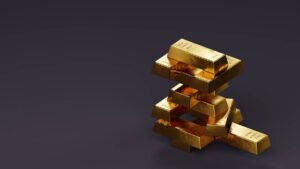Gold demand hit new highs in 2023… and investors are still running for safe haven

Pic: Simonkr/E+ via Getty Images
- Gold prices hit an all time high average in 2023 as war and geopolitical instability sent investors running for safe haven assets
- The World Gold Council says including Over-The-Counter market, demand rose 3% to an all time high in 2023
- But equities are being weighed down by rising costs, Metals Focus says
War, what is it good for?
Gold, which saw demand hit new high in 2023 … if you take the “opaque” over the counter (OTC) investment market into account.
That tells a story in itself. OTC sales are non-exchange gold trades largely conducted by large institutional investors.
And data from the World Gold Council shows they surged last year as well-heeled investors sent OTC demand up a stunning 753% to 450.4t.
That saw overall gold demand rise 3% to 4898.8t against the 4751.9t procured last year.
With OTC demand removed, the hunger for gold driven heavily by strong central bank buying hit 4448.4t, only 5% down on 2022’s high watermark of 4699t.
It shows demand for gold remains strong as a hedge against both economic and geopolitical uncertainty, with the average LBMA gold price up to a record US$1940.54/oz in 2023 and prices closing last year up 15% at an all time high of US$2078.4/oz.
They closed Tuesday night at US$2043.05, with investors waiting from interest rate guidance from the US Fed meeting overnight to get a sense of where prices will be headed in 2024.
World Gold Council head of Asia Pacific and global head of central banks Shaokai Fan said the rise in OTC demand showed buyers were showing strengthening interest in gold investment.
“I think opaque might be the wrong word because opaque has negative connotations. The OTC market is actually one of the most common ways to trade gold like in London; for instance, most of the gold that’s traded there is on the OTC market and not on the exchange traded market,” he said.
“In Singapore too for instance, a lot of the gold that’s traded in Singapore is OTC. So, I think it tells me that there’s certainly a lot more interest in gold in general, and there might be a lot of buyers out there who are seeking access to gold through different ways.
“It just points to more interest and more activity in the gold market throughout the course of last year.”
Central banks remain a tailwind
In recent years manic buying from central banks has been the fuel for a bullish run in gold prices.
They remained strong purchasers in 2023, with demand from central banks falling 4% from record highs in 2022 to 1037.4t.
The last quarter of 2023 was down 40% in that arena from record levels in December 2022 at 229.4t, though Fan noted it was coming off an extremely high base.
“Overall our view for demand this year is still quite optimistic. I think on the central bank side first of all, central banks will definitely stay net buyers,” Fan said.
“They may not reach the record highs that we’ve seen in the last two years or so but that case for buying gold is still quite compelling for them.”
Fan said the debate in Congress of the REPO Act, which would give the US the ability to assume frozen Russian assets in the US for delivery to the Ukraine, has underlined moves in the East to seek alternatives to US dollar investment.
That has trickled down also to bar and coin demand among Chinese investors, against the backdrop of trade friction between the superpowers.
“If it is signed, it would be a pretty significant change in the use of the dollar and the US financial system for policy objectives because it would be the first time the US would be confiscating the assets of a country that it wasn’t directly in a military conflict with,” Fan said.
“I think if that happens that might trigger maybe some more thinking among central bankers around the world about the composition of the reserve assets and maybe they might seek ways to minimise political connection. And gold obviously is one way they can do that.”
How far the US Fed goes to cut rates, and provide steam for gold prices, will depend on whether it sees a soft or hard landing from last year’s rate rises.
“We’ve seen some recent US data signaling potentially more of a soft landing scenario. So if the US starts to cut rates, I think obviously that is going to be a good thing for the gold market,” Fan said. “If it needs to start cutting rates aggressively, though, if we see the economy start to falter, that would be very bullish for the gold market.”
Jewellery prices dull Aussie demand
While higher prices are a blessing for gold producers, they did contribute to a 34% drop in consumption within Australia, with jewellery demand down 6% and bar and coin investment sliding 46% amid a cost of living crisis.
Gold-backed ETF holdings were also down 2t.
Higher prices have spurred investment in supply, with mine production up 1% YoY to 3644t — albeit short of the 2018 record — and recycling up 9% YoY to 1237t.
Lower output from war-torn Sudan, Indonesia and Mexico as well as Australia, where output fell 2% or 7t on the year, saw mine supply fall 12t short of 2018’s highs after a strong first half.
But a number of new mines with a combined capacity of 13t are expected to start in 2024, with Bellevue Gold’s (ASX:BGL) 6.2tpa mine of the same name in WA the largest.
While prices are hovering around record highs, costs are still eating heartily into margins, with Metals Focus reporting that costs globally in the third quarter of 2023 were at a record high.
“Although inflation, in the input costs of gold production, has shown signs of easing, AISC continued to rise due to some operational constraints,” analysts at Metals Focus said.
“AISC grew by 5% y/y and 2% q/q in Q3.23, reflecting increased growth rates in mine site costs per gold ounce produced as most gold mines incurred higher fuel prices while processing less ore tonnage during the quarter.”
Average gold grades globally also fell 3% QoQ to 1.33g/t. However, at current prices gold remains largely profitable with around 7% of miners operating at a loss in September last year against over 20% at the same time in 2013 and 9% on the same period in 2022.
Yet higher costs have left investors wary on gold equities.
The GDX — the leading ETF of international gold miners — was trading at $54 in the third quarter 2012 with prices at just US$1653/oz. And despite rising from US$1912/oz to US$1978/oz between Q3 2020 and Q3 2023, the GDX fell from $39 to $30 over that period.
“Mines operating with a $1,343/oz AISC would have been driven to suspension or closure if this persisted five years ago, but currently AISC margins remain healthy due to a higher gold price,” Metals Focus said.
“However, the inflated cost of extracting gold is dampening what mining companies could earn in profits in this high gold price market. This is demonstrated by the disparity in the performance of the GDX VanEck Gold Miners ETF and the gold price since 2021.”
Aussie gold miners round out reporting season
A couple of the gold miners who saw massive gains in 2023 on operational improvements — Westgold Resources (ASX:WGX) and Red 5 (ASX:RED) – dropped their December quarter reports yesterday.
Westgold produced 59,238oz from its Murchison gold mines in the three months to December 31 at AISC of $2245/oz Australian.
That saw the company rack up $47m of operating cash flow and a $21m cash build with average gold prices a tidy $3041/oz.
WGX attributed part of its cost increases to a competitive labour market in WA, saying remuneration and staff benefits issued to attract and retain talent making a big debt in the 9% cost increase in the three months to December 31.
Mill downtime at the Bluebird and Tuckabianna mills were also a factor, along with higher than expected diesel costs from delays in a transitional period to gas and renewable energy, as well as supply contract inflation.
Its fourth hybrid power station at Bluebird was commissioned this month, with the installation of 82MW of gas and renewable capacity expected to save $60/oz on a diesel price of $1.64/l.
Shares in Red 5 fell 4.5% despite the King of the Hills owner saying it was on track to hit the top end of its 195,000-215,000oz guidance range for FY24.
The Leonora gold mine delivered 53,087oz at an AISC of $2328/oz, heavily impacted by a non-cash inventory expense.
After producing 108,027oz at $2008/oz in the December half, RED says it remains on track to fall within its guidance range of $1850-2100/oz.
Having a harder time of things was Catalyst Metals (ASX:CYL), which sold 26,336oz at an AISC of $2861/oz.
Its Plutonic mine in WA sold 21,030oz at $2713/oz, but its Henty operation in Tasmania was a straggler, producing 5306oz at eye-watering costs of $3447/oz.
CYL says it has been able to run at plant rates above 300,000tpa, suggesting higher production levels, and the replacement of ageing fleet and a transition from remnant mining to new areas will improve operations at Henty in the next two years.
Westgold Resources (ASX:WGX), Red 5 (ASX:RED) and Catalyst Metals (ASX:CYL) share prices today
Related Topics

UNLOCK INSIGHTS
Discover the untold stories of emerging ASX stocks.
Daily news and expert analysis, it's free to subscribe.
By proceeding, you confirm you understand that we handle personal information in accordance with our Privacy Policy.








